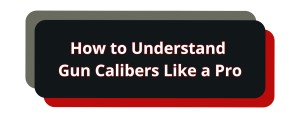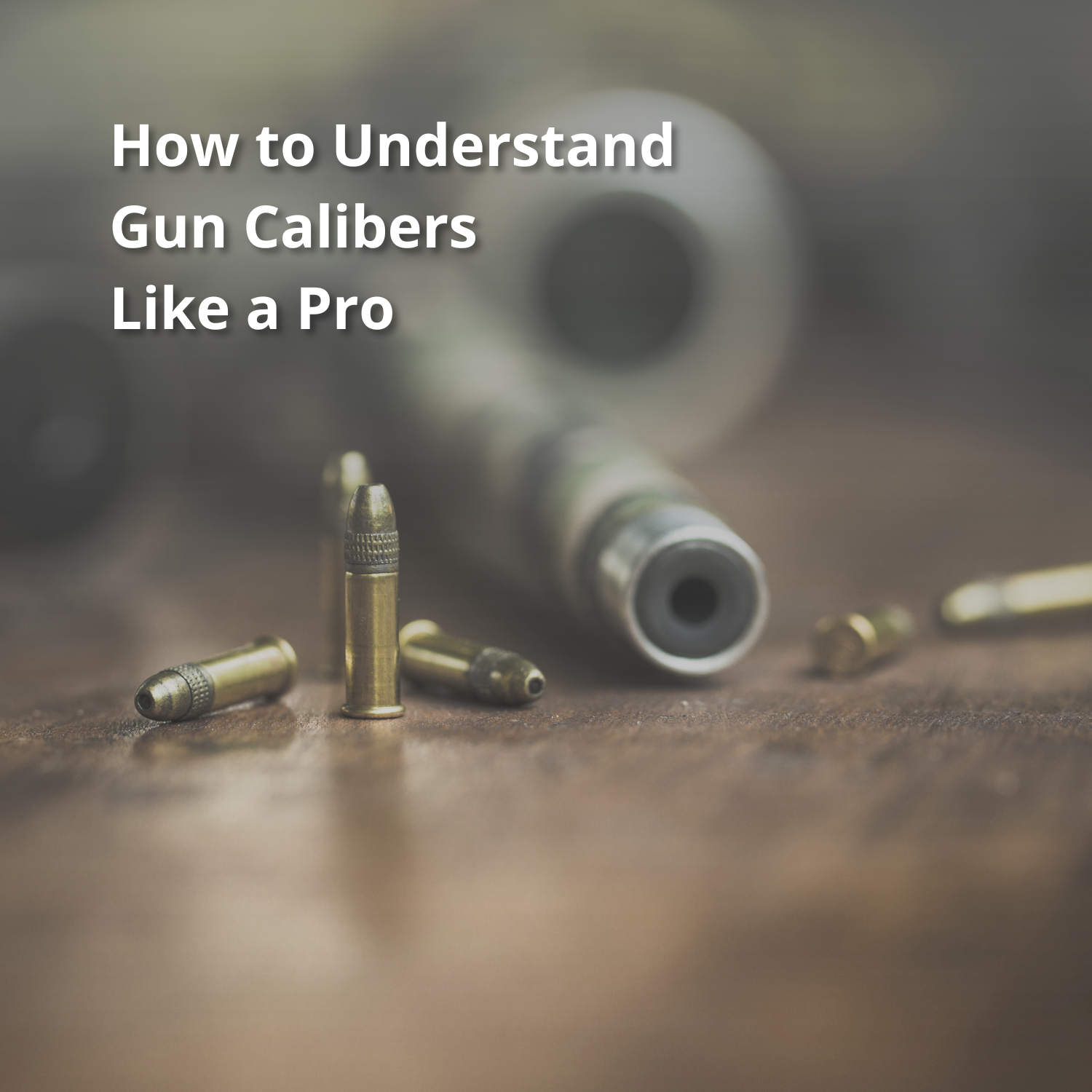
Gaining confidence while discussing and choosing firearms requires first learning the fundamentals. Understanding these concepts will help you make knowledgeable decisions and engage in stimulating conversations regarding weaponry, from the fundamental meaning of caliber to interpreting measurements like an expert. With concise explanations and useful insights, this guide aims to make the complexities easier to understand.
What is a Gun Caliber?
Gun caliber refers to the internal diameter or bore of a gun barrel, usually measured in inches or millimeters. The caliber of a gun is crucial as it determines the size of the bullet that can be fired from it. Knowing how to read and understand these measurements is essential for any gun enthusiast.
How Caliber is Measured
Gun calibers are typically measured in either inches (imperial system) or millimeters (metric system). For example, a .45 caliber firearm has a bore diameter of 0.45 inches, while a 9mm firearm has a bore diameter of 9 millimeters.
Imperial System vs. Metric System
Understanding the difference between these systems is key to mastering gun calibers. The imperial system, used mainly in the United States, measures caliber in inches, while the metric system, used globally, measures caliber in millimeters.
Why Caliber Matters
The caliber of a firearm plays a significant role in its performance, handling, and suitability for various purposes. A larger caliber typically means a more powerful bullet, which can be necessary for specific tasks like big game hunting or military use. Conversely, a smaller caliber might be preferred for target practice or small game hunting due to its lower recoil and cost.
Different Types of Gun Calibers
Handgun Calibers
Handguns come in a variety of calibers. Some common ones include:
- .22 Long Rifle (.22 LR): Often used for training and small game hunting due to its low recoil and affordability.
- .380 ACP: A popular self-defense caliber known for its manageable recoil.
- 9mm: Widely used by law enforcement and military around the world, known for its balance of power and recoil.
- .45 ACP: Known for its stopping power, often used in self-defense and military applications.
Each of these calibers has its own characteristics, making them suitable for different scenarios. For instance, the .22 LR is favored for its accuracy and low cost, making it ideal for beginners and casual shooting. On the other hand, the .45 ACP is renowned for its stopping power, making it a preferred choice for self-defense.
Rifle Calibers
Rifles also have a range of calibers suited for different purposes. Some examples are:
- .223 Remington/5.56 NATO: Commonly used in AR-15 style rifles, popular for both sport shooting and military use.
- .308 Winchester/7.62 NATO: Known for its accuracy and power, used in hunting and sniping.
- .30-06 Springfield: A versatile caliber used for hunting large game.
Rifle calibers vary significantly in terms of power and application. The .223 Remington, for instance, is favored for its versatility and is commonly used in both military and civilian rifles. The .308 Winchester, with its greater power and range, is often chosen for precision shooting and big game hunting.
Shotgun Calibers
Shotguns are a bit different as they use gauge instead of caliber to measure the barrel diameter. Some common gauges include:
- 12 Gauge: The most versatile and widely used, suitable for hunting and self-defense.
- 20 Gauge: Offers less recoil than 12 gauge, making it suitable for smaller game and younger shooters.
- .410 Bore: The smallest of shotgun calibers, used for small game hunting and training.
The gauge of a shotgun determines its intended use. The 12 gauge is the most popular due to its versatility, making it a go-to choice for various hunting scenarios and home defense. The .410 bore, with its lower power, is excellent for beginners and small game hunting.
Reading Caliber Labels
Understanding Ammunition Labels
When you purchase ammunition, you’ll see various numbers and letters that indicate the caliber. For example, a box labeled “9mm Luger” specifies the caliber as 9mm, and the term “Luger” indicates the specific type of 9mm cartridge.
Understanding ammunition labels is crucial for ensuring you use the correct ammunition for your firearm. Using the wrong ammunition can be dangerous and damage the firearm. Always check the firearm’s manual and match the ammunition specifications precisely.
Interpreting Metric and Imperial Measurements
It’s essential to be able to interpret both metric and imperial measurements. A .308 Winchester caliber can also be referred to as 7.62x51mm NATO in metric terms, meaning the bullet diameter is 7.62 millimeters and the cartridge case length is 51 millimeters.
This duality in measurement systems can be confusing for beginners. However, knowing both systems allows for better comprehension when purchasing firearms and ammunition, especially from different countries.
Choosing the Right Caliber for Your Needs

Self-Defense – For self-defense, choosing a caliber with sufficient stopping power and manageable recoil is crucial. Common choices include 9mm, .40 S&W, and .45 ACP for handguns. The 9mm is a popular choice due to its balance of power, recoil, and capacity. It’s widely used by law enforcement agencies worldwide, making it a reliable option. The .45 ACP, with its greater stopping power, is often chosen by those who prioritize maximum defensive capability.
Hunting – When hunting, the choice of caliber depends on the game being hunted. Smaller calibers like .22 LR are suitable for small games, while larger calibers like .308 Winchester are better for big games. For instance, the .30-06 Springfield is a favorite among hunters due to its versatility in handling various game sizes. Meanwhile, the .223 Remington is ideal for varmint hunting and pest control.
Sport Shooting – For sport shooting, especially in competitive environments, accuracy and recoil management are key. Popular calibers include 9mm for handguns and .223 Remington for rifles. Competitive shooters often prefer the 9mm due to its accuracy and manageable recoil, which allows for quicker follow-up shots. The .223 Remington is favored for its flat trajectory and precision, making it ideal for target shooting.
Common Misconceptions About Gun Calibers
Bigger is Always Better – A common misconception is that a bigger caliber always means better performance. In reality, the effectiveness of a caliber depends on various factors, including the intended use, the shooter’s experience, and the firearm itself. Bigger calibers do offer more stopping power, but they also come with increased recoil, which can be challenging for some shooters. It’s essential to find a balance that works for your specific needs and comfort level.
All Calibers are not Interchangeable – Not all calibers are interchangeable. Using the wrong caliber ammunition in a firearm can be dangerous and damaging. Always ensure the ammunition matches the firearm’s specifications. This point cannot be overstressed. Using incorrect ammunition can lead to catastrophic failures and serious injuries. Always double-check your firearm’s caliber markings and match them precisely with your ammunition.
Conclusion
Mastering the understanding of gun calibers involves learning how to read measurements, knowing the differences between calibers, and choosing the right caliber for your needs. With the information provided in this article, you’re now equipped to understand gun calibers like a pro. Whether you’re a beginner or an experienced shooter, this knowledge will enhance your confidence and competency in handling firearms.




